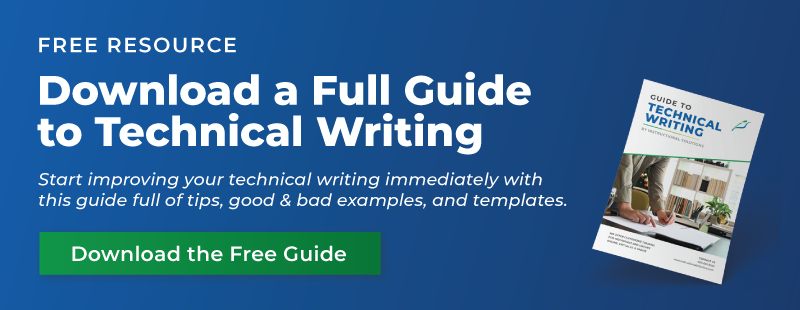How to Write an Effective Policies and Procedures Manual

Writing with AI - Learn more


Policies tell readers what to do and why it's done. Procedures tell readers how to do it. Together, they define an organization and ensure operations run smoothly.
Written by technical writers, a policies and procedures manual combines policies and procedures into one document. Readers such as managers can reference the manual to carry out operations appropriately.
Let's dig into the technical writing definition of this manual, its benefits, and how to write a policy and procedures manual for your organization effectively.
A policies and procedures manual is an internal document that details a company's policies and procedures that ensure employees follow the policies.
Although closely related, here are the differences between policies and procedures:
The big keyword for policies is “guiding." Policies direct, guide, and influence decision-making, daily operations, actions, and strategies. They establish a framework of management philosophies, aims, and objectives.
Policies are broad and general. They don't tend to change frequently, and cover various topics:
Communication policies, an anti-racism policy, a dress code policy, and a disciplinary policy are other examples.
Here's a specific example: a public school might have a single policy that a fire drill should be held once a month to ensure safety in an emergency that requires an evacuation.
Procedures describe, step by step, what actions to take in specific instances.
These narrow-focused documents have a beginning and an end and should be strictly followed to achieve the desired outcome. Procedures continuously change and improve, offering a detailed description of activities.
Procedural topics include:
Payment procedures, inspection procedures, and technology usage procedures are other examples.
Let's revisit the fire drill policy. Following the policy, the fire drill procedure maps out where each classroom should go in the case of a fire drill, noting specific routes and offering alternatives. The procedure will likely change and improve as the drills are practiced.
A policies and procedures manual place all policies and procedures in one document so management, supervisors, and other employees can easily reference and meet expectations for company operations.
Having this manual benefits the company in multiple ways:
This manual is also helpful during annual company audits. Organizations are often required to give auditors internal controls and policies for their audit reports. A manual shows that your controls and policies are well-documented.
Related: Guide to Strong Policy Writing
Take a step-by-step approach to planning and writing a manual:
First, understand who will be reading your manual. You'll use this info to plan out what content will go into the document and how you'll structure the sections. The time spent planning will save you time when you start writing.
Your manual's reader is one of the most important elements of planning your manual. Who is going to read the document, and what are their needs? The typical readers of this manual are
What do you want the reader to know or do? What's the purpose of the document? Answer these questions before planning out the content.
Once you have your audience analysis, map out what information will go into the manual. You'll likely have to research pre-written policies and if procedures need to be written to accompany the policies.
Perhaps you already have a separate policy manual and procedure manual. Pull the information from these documents to combine it into a cohesive manual. We recommend creating an outline or concept map to organize your details and determine how you want to categorize and sequence the info.
Here's an example sequence to follow for your manual:
Collaborate with your team members (e.g., managers who understand company policies). Get their opinions on the content you've generated and if you're missing key information. Add to your outline or concept map if so.
Now that you have a detailed content plan, time to draft the actual policy and procedure manual. Here are a few tips for creating a reader-focused policy:
Also, try to use simple language rather than falling back on jargon. Remember that the document should be easy for your reader to understand.
Related: Procedure Writing
Ensure that your manual is easy for managers, supervisors, and employees to access. We recommend publishing online so the manual can be accessed by computer or mobile device. You could publish through an internal portal or even on your website, like Coca-Cola. Coca-Cola has an entire library of policies!
Your manual shouldn't be a stagnant document. Changes constantly occur in an organization, such as by-laws or the executive team. Make sure it's up-to-date by reviewing it at least once every year.
Schedule a specific time for an annual or bi-annual review. Check if any procedures need updating or if a policy doesn't apply anymore. Involve managers and the policy team in the process. Ask how the manual is being used and if there are any gaps or common employee questions. Add or revise sections as needed.
Equipped with these steps, you're ready to create your company's policies and procedures manual. Remember: planning can save you so much time with this complex document. Plan out your document before you ever begin writing.
At Instructional Solutions, we offer online technical writing courses with comprehensive lessons, exercises, and individualized feedback to help new or experienced policy and procedure writers. No matter your policy or procedure assignment, Instructional Solutions helps you take a technical writing approach to create effective policies and procedures.
Enroll in our online, self-paced writing course and get detailed feedback on your actual technical writing.
Download the Outline